Community tanks are fun to watch because of the bursts of colours from fish zipping from corner to corner, complemented by lush green forests of plants and moss, and dancing lines of light from the lighting subdued by driftwood and rock caves. Community fish are like directors, directing the watcher’s eye into what’s worth seeing – the rock work, the meticulously trimmed plants, the spectacular light show, and of course, themselves!
Community fish like tetras, guppies, and platys are often the go-to types of fish because of their bright colour patterns, majestic fins, or playful personalities. Unfortunately, this means that quite a lot of fish go under the radar simply because they may not have been given a fair chance to strut their stuff in the pet shop. This list will show you some of the fish you might have seen but have never really “seen” in their full glory. Before we go over the list, here are the some of the things one must take into consideration when choosing fish for your community tank.

Table of Contents
Criteria for the Ideal Community Fish
- Must not be hostile and territorial towards other fish species
- Must readily consume prepared food like pellets or flakes
- Must tolerate a wide range of aquarium conditions
1. Kuhli Loaches

Kuhli loaches are playful, active little fish that look like tiny eels. Kuhli loaches have often been overlooked by a lot of aquarists simply because they aren’t as popular as Corydoras. The bare bottom minimalist setups in pet stores don’t do them any favours either, as they tend to be more reclusive when there aren’t a lot of hiding places and soft substrates for them to explore or play in. In well-planted plants with sandy substrates, however, it actively scurries around, looking for scraps of food on plant leaves, decor, and other parts of the tank. It doesn’t bother even the most timid tank mates, and it can even be kept with adult freshwater shrimp!
- Size- 4 inches
- Difficulty-Intermediate
- Minimum Tank Size- 15 gallons
2. Forktail Rainbowfish

Forktail rainbowfish are some of the most striking freshwater community fish out there, with its bright blue eyes, iridescent coloration, and yellow accents on its fins. Their fins are shaped almost like that of a hatchetfish, except that they are less likely to jump out of your aquarium. These fish are quite active and add an impressive splash of colour to any tank, and will not pose any harm to more placid community fish.
- Size- 2 inches
- Difficulty- Easy
- Minimum Tank Size- 30 gallons
3. Threadfin Rainbowfish

Threadfin rainbowfish are peaceful, beautiful fish that aren’t often given a fair chance to show off their subtle colourations and splendid fins in a crowded, stressful pet store aquarium. When healthy, these fish display surprisingly intense colours when they spread out their fins, with a bright red glow and a subtle iridescence that contrasts beautifully in a well-planted tank with a dark substrate. They also have small mouths that make them perfect tank mates for smaller shrimp and other small fish.
The Threadfin Rainbowfish features a rainbow of colors on its body, including grey, yellow, red, blue, and dazzling colors extending to its fins. The Threadfin Rainbowfish enjoys clean, slow-moving streams, grassy wetlands, and lagoons with lush vegetation.
The rainbowfish family members are widespread in freshwater aquaria because of their ordinarily calm attitude, durability, and beautiful colors.
- Size- 2 inches
- Difficulty- easy
- Minimum Tank Size- 15 gallons
4. Lampeye Killifish

Like the threadfin rainbowfish, the lampeye killifish looks rather drab and unexciting when placed in a poorly-lit, dirty, and stressful tank. When in a well-maintained well-lit planted tank, however, their eyes display a mesmerising electric blue colour that seem to flash as they zip around the tank. They’re relatively hardy – almost as hardy as guppies and platys, but may be a bit harder to find in pet shops.
- Size- 1.5 inches
- Difficulty- Intermediate
- Minimum Tank Size- 20 gallons
5. Glass Catfish

Glass catfish are unique fish that, much like the ghost shrimp, have transparent bodies that give aquarists a peek into their internal organs. This means you get to see food getting digested with the backdrop of the plant or decor the catfish swims in front of – a rather unique and exciting fishkeeping experience for a lot of people. They’re quite peaceful, but they tend not to move around like the other fish in this list.
One could oftentimes see them just staring blankly into space in a dark corner (it doesn’t like bright lights). This fish is nocturnal, so it’ll be more active during the night, and pretty much in a zombie-like state in the morning. That said, it’s a good idea to keep this fish in a well-planted tank with plenty of hiding spots and coves so that it feels safer and will more likely swim out into the open much more frequently.
- Size- 3 inches
- Difficulty- Moderate
- Minimum Tank Size- 30 Gallons
6. Peacock Gudgeon
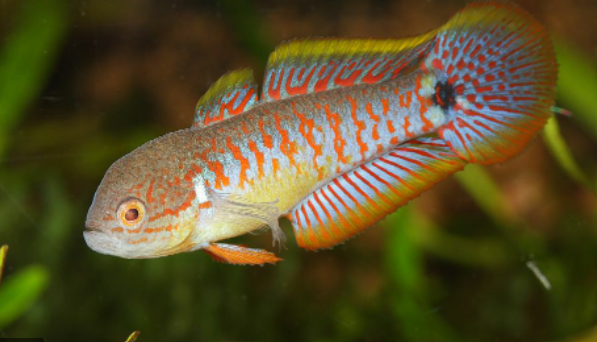
Peacock gudgeons are colourful fish that not all aquarists will readily buy due to their relatively higher price tags. Plain, bare bottom tanks in pet shops also don’t do their eccentric, vivid colourations any favour, either. Like a peacock, it has bright red markings on its metallic blue body and fins.
A closer look reveals a captivating, bright yellow outline on its fins. This fish does well either as a pair or as a group of 6 to 8 or more, and will thrive even in small tanks.
However, that while the peacock gudgeon is safe to keep with community fish, it isn’t necessarily going to be safe to keep with small shrimp, as it is considered a micro predator. If you wish to keep them with shrimp, make sure you have a lot of java moss for the shrimp to hide in.
The Peacock Gudgeon is a freshwater fish found in shallow water bodies in Papua New Guinea. It is a vibrant fish known for its calm and active characteristics.
Males will often pose with one another, but they will seldom engage in sustained combat, especially in an aquarium with various plants, rockwork, driftwood, and other hiding spots. When maintained in optimal conditions, a Peacock Gudgeon’s lifespan in captivity is between 4 and 5 years.
- Size- 3 inches
- Difficulty- easy
- Minimum Tank Size- 15 gallons
7. Red Lizard Whiptail

The red lizard whiptail looks like a plecostomus with a thin, elongated body and high dorsal fin. What’s interesting about this fish is that nobody’s really sure where this fish truly came from – is it manmade or is it wild-caught? This catfish is also one of the most peaceful yet playful – almost like otocinclus – making them perfect for any community tank.
- Size- 4.4 inches
- Difficulty- Easy
- Minimum Tank Size- 30 gallons
8. Glowlight Tetra

The glowlight tetra is a beautiful fish that is surprisingly easy to care for and stay healthy. It is a quiet and easygoing fish that can survive in a wide range of aquarium conditions. The glowlight tetra is a captive-bred fish that you may purchase in Asia and Germany. It was introduced to the aquarium trade in 1933. You should have at least six of them in your tank.
- Size- 1.5 inches
- Difficulty- Easy
- Minimum Tank Size- 10 gallons
9. Bristlenose Pleco

Because of their distinctive appearance and tendency to keep algae at bay, Bristlenose Plecos are a fantastic addition to any aquarium. The Bristlenose Pleco is one of the smallest catfish, measuring about 3 to 5 inches long. They have brown, green, or grey bodies with white or yellow spots; others have uneven coloring with brighter and darker splotches on various parts of their bodies. The fish’s most noticeable characteristic is the bushy nasal appendages that sprout from their snouts.
- Size- 3-5 inches
- Difficulty- Easy to Intermediate
- Minimum Tank Size- 40 gallon
10. Dwarf Gourami

The Dwarf Gourami, or Trichogaster Iulius, is a colorful freshwater fish that belongs to the Gourami family. In India, West Bengal, Assam, and Bangladesh, the dwarf gourami is only found in heavily vegetated lakes. If properly cared for, dwarf gourami may live for four years. Regularly add live foods like worms to their diet to keep them healthy.
- Size- 2 inches
- Difficulty- Intermediate
- Minimum Tank Size- 5 gallon
11. Guppy Fish

Guppies are popular farmed freshwater fish known for their vibrant colors and quick reproduction. Even though the guppy has been kept in captivity for over a century, it is of South American native.
This species is perfect for beginners. They’re challenging, straightforward, and get along with others in a group setting. Guppies are peaceful, easygoing communal fish that get along with many non-aggressive species.
- Size- 2 inches
- Difficulty- Beginner
- Minimum Tank Size- 10 gallon
12. Dwarf Pencilfish

Nannostomus marginatus is one of the genus’s tiniest and most distinctive members. According to some reports, although these species are successfully bred in home aquariums, it is difficult to do so. It has a tiny mouth and huge eyes and has a slender, elongated, spindle-shaped body. Its tail fin is translucent.
Remember that, despite its disease resistance, the fish is quite sensitive to sudden changes in water conditions.
- Size- 1.5 inches
- Difficulty- Easy
- Minimum Tank Size- 4 gallons
13. Neon Tetra

The neon tetra is a freshwater fish species belonging to the tetra fish family. Their bodies are vivid blue, with striking red stripes going from the belly to the tail. Despite its modest size, the neon tetra has a thin torpedo-shaped body that doesn’t stretch much beyond an inch and a half in length.
The northern and western Amazon basins of Peru, Brazil, Colombia, and the eastern Amazon basin are home to neon tetras. Neon tetras should not be used in freshly setup tanks since they will not be able to endure the changes that occur during the initial startup cycle.
- Size- 1.5 inches
- Difficulty- Intermediate
- Minimum Tank Size- 10 gallon
14. Celestial Pearl Danio

There are small, leafy ponds in Southeast Asia where Celestial Pearl Danio lives. They were found in Myanmar, where they lived in little ponds. Nano Schooling fish are the most common type of fish. They like living in groups.
- Size- up to 1 inch
- Difficulty- Easy
- Minimum Tank Size- 10 gallons
15. Congo Tetras

As their name suggests, these fish are only found in the Congo River basin and nowhere else on the earth. The Congo tetra loves thick vegetation, few trees, and substrates made mainly of sand, silt, and mud, among other things. They often establish their habitats near small streams, ponds, and marshes.
Because Congo Tetras are sensitive to stress, monitoring their food and water is challenging.
- Size- 2.5 to 3. 5 inches
- Difficulty- Moderate
- Minimum Tank Size- 30 gallons
16. Platy Fish
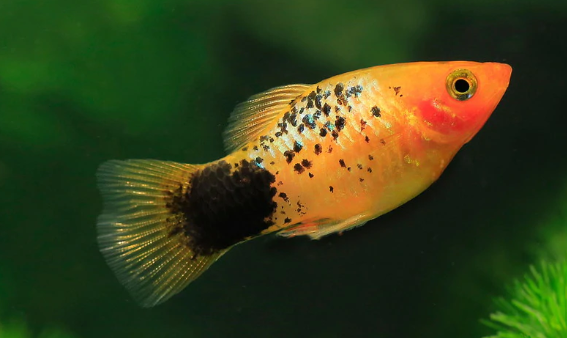
Platies are a popular livebearer in the freshwater aquarium industry. They are native to Mexico and Central America. They prefer densely forested areas with sandy or silty bottoms, darting in and out of plants to acquire food and avoid predators.
Healthy platies may live up to 3-4 years if kept in perfect conditions with clean water, minimum stress, and superb nutrition.
- Size- 2-3 inches
- Difficulty- easy
- Minimum Tank Size- 10 gallons
17. Cardinal Tetra
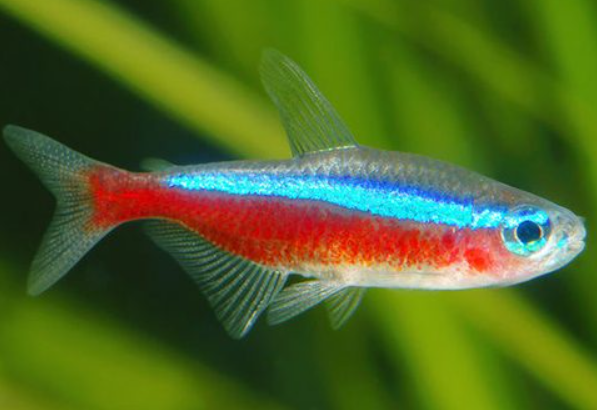
A brilliant neon blue stripe that extends from the nose to the tail distinguishes the cardinal tetra. Cardinal tetras may grow two inches long and are quite popular among aquarists because of their brilliant colors and peaceful demeanor.
Other tetra species, danios, rasboras, and dwarf gouramis, are tiny to medium-sized catfish family members who are acceptable tankmates. Other tetra species might be involved.
- Size- 2 inches
- Difficulty- Intermediate
- Minimum Tank Size- 20 gallon
18. Bala Shark

Bala sharks may be found in Southeast Asia’s medium to big rivers and lakes. Previously, they were found in Thailand, Borneo, Sumatra, and the Malayan peninsula, among other locations.
Despite their name, which indicates a similarity to sharks, they are feared predators. The term originates from the friendly freshwater sharks with similar body shapes and triangular-shaped dorsal fins.
You may keep juvenile Bala sharks with a wide variety of species because of their generally peaceful demeanor. However, as they get bigger, they will eat small fish.
- Size- 13 inches
- Difficulty- Easy to intermediate
- Minimum Tank Size- 120 gallon
19. Black Skirt Tetra

Black skirt tetras live in the tiny, sluggish tributaries and streams of Brazil’s Guapore and Paraguay Rivers, where the forest canopy offers refuge and food. A variety knows them by name.
Black skirt tetras are little tetras that grow to be around two inches long as adults. Long-finned types are somewhat more extensive than hybrids.
- Size- 2 inches
- Difficulty- Easy
- Minimum Tank Size- 10 gallons
20. Molly Fish
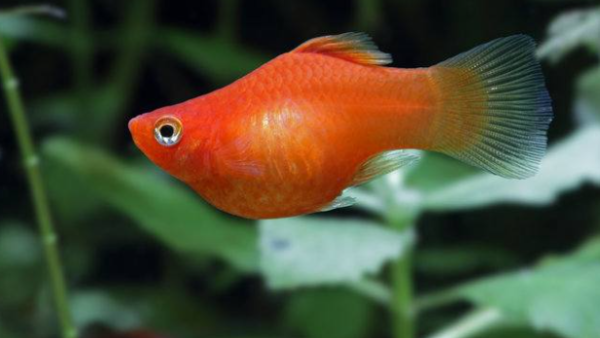
Mollies are most often seen in the southern United States and Central America. This fish’s natural range extends from the south of the United States to Mexico’s Yucatan Peninsula.
Mollies may live and reproduce in shallow marine habitats such as ports and the waters near mangrove roots. Common variants include solid black mollies and sailfin kinds with orange-bordered dorsal fins.
- Size- Up to 5.5 inches
- Difficulty- Easy
- Minimum Tank Size- 10 gallons
21. Siamese Algae Eater

Bottom-dwelling Siamese algae eaters are found only in small streams and rivers in Malayan and Thailand. These fish are suitable for beginners since they make tank maintenance much easier, and their behavior is unlikely to be an issue.
The body of a Siamese algae eater is long and thin, reaching up to six inches in length. They have a black stripe extending from head to tail and are usually light grey or yellow.
- Size- 6 inches
- Difficulty- Easy
- Minimum Tank Size- 20 gallons
22. Sparkling Gourami

Sparkling gouramis are members of the gourami family of freshwater fish. It’s a kind of gourami, and one can only find this fish in Southeast Asia. These fishes will swim to the water’s surface to acquire oxygen occasionally. These Gouramis are pretty minor and may live for up to 5 years, and if maintained in correct aquarium settings, they may live for an extended time.
- Size- Up to 1.6 inches
- Difficulty- Easy
- Minimum Tank Size- 15 gallons
23. Cory Catfish

Bandit Corys are one of the most well-known members of the Cory family and have been around for a long time in the aquarium trade. There are several different types of Cory Catfish, each with its size and color, but Bronze Cory Catfish are the most common.
The black mask that conceals their eyes easily distinguishes them. According to research, bandits are more sensitive to variations in water temperature than other species.
- Size- 2 inches
- Difficulty- moderate
- Minimum Tank Size- 10 gallon
24. Marbled Hatchetfish

Because many hatchet fish are wild-caught, you should keep them in a quarantine tank for a few weeks before introducing them to your main fish tank. Because the Marbled Hatchetfish is a schooling fish, it should be kept in groups of at least six.
To feel comfortable and settle in, this timid, terrified small fish need the companionship of other fish of its kind.
- Size- 2 inches
- Difficulty- Intermediate
- Minimum Tank Size- 15 gallons
25. Otocinclus
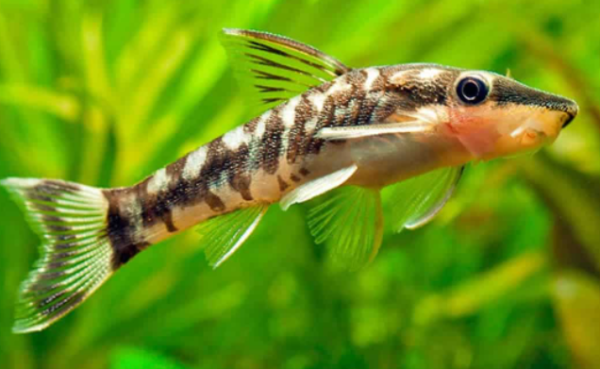
An Otocinclus Catfish is an excellent tiny scavenger for freshwater aquariums, and they’re also quite simple to care for. These fish are among the world’s most skilled algae eaters, and they are pretty easy to care for due to their natural diet.
There are around 19 different species of Otocinclus, and they come in a variety of sizes, patterns, and colors. Ensure the water is well-filtered and flowing slowly and that the ammonia and nitrate levels are both 0 parts per million (ppm), with nitrates being very low.
- Size- 1-2 inches
- Difficulty- Easy
- Minimum Tank Size- 10 gallons
26. Bolivian Ram Cichlid

Bolivian Ram is a freshwater fish that is fun to watch. They’re shy and won’t bother the other fish in your tank. They are perfect for a community fish tank. The average time it takes to raise a Bolivian Ram to maturity is four years. They are members of the Cichlidae family, which is the most populous of the freshwater fish families. The form of their body is elongated and oval.
- Size- 3.5 inches
- Difficulty- Beginner
- Minimum Tank Size– 30 gallons
27. Pearl Gourami
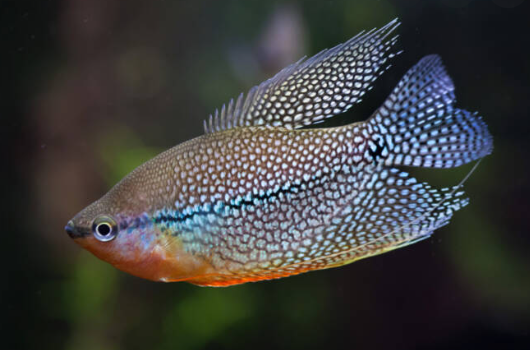
This species is found in Thailand, Malaysia, and the Indonesian islands of Borneo and Sumatra. The pearl gourami is thought to spend most of its time in the higher reaches of the water in which it lives in its natural habitat.
Although pearl gourami is typically a peaceful fish that thrive in a community tank, they should not be housed in the same tank with other aggressive fish. A horizontal black line runs from the mouth to the tail, eventually coming to a halt at the tail’s end.
- Size- 4.5 inches
- Difficulty- Easy
- Minimum Tank Size- 20 gallons
28. Cherry Barb

Puntius titteya is the scientific name for Cherry Barbs, which belong to the Cyprinidae family and contain salmon. The Cherry Barb is a blooming plant native to Sri Lanka, and you may find it in the Kelani and Nilwala river basins.
These fish thrive in communities as peaceful as they are in their natural condition. The bulk of Cherry Barbs will be tan to dark brown with red or orange highlights.
- Size- 1-2 inches
- Difficulty- Easy
- Minimum Tank Size- 25 gallons
29. Ember Tetra

The Ember Tetra, sometimes known as the Fire Tetra, is a small freshwater fish belonging to the Characidae family indigenous to Central-Western Brazil’s slow-flowing rivers.
Backwater rivers with sluggish currents and plentiful vegetation are ideal to dwell in. Ember Tetra comes from a very forested and lushly vegetated environment. The existence of plants has profoundly influenced these species’ behavior.
- Size- 0.6–0.8 inch
- Difficulty- Easy
- Minimum Tank Size- 10 gallons
30. Chili Rasbora

The Chili Rasbora, sometimes known as the Mosquito Rasbora, is a tiny freshwater schooling fish that has become quite popular among aquarists. It belongs to the Rasbora genus.
Chili Rasbora is a little fish that lives at the top and middle of the aquarium’s water column, making it easy to see despite its diminutive size. Depending on how well it is cared for, the average Chili Rasbora may survive for 4 to 8 years.
- Size- .6-.8 inch
- Difficulty- Easy
- Minimum Tank Size- 5 gallon
31. Honey Gourami

Honey gourami is simple to care for and may be done by aquarists of all skills and knowledge. This species is a good option for newbie aquarists because of its calm disposition and durability.
These fish, which are endemic to Bangladesh and India, need slow-moving water that is heavily vegetated and brimming with plants and other vegetation. The Honey Gourami is smaller than the other gouramis, with a thinner body and smaller dorsal and anal fins.
- Size- 3 inches
- Difficulty- Beginner
- Minimum Tank Size- 10 gallons
32. White Cloud Mountain Minnow

The geographic origins of this fish have changed dramatically throughout China and Vietnam, and these changes have had a significant impact on its habitat. They may live for 5 to 7 years and are pretty popular among novices, especially those just getting started. As an adult, white clouds may grow 1.5 inches long, with the males being slenderer and more colorful than the females.
- Size- 1.5 inches
- Difficulty- Easy
- Minimum Tank Size- 10 gallons
33. Pictus Catfish
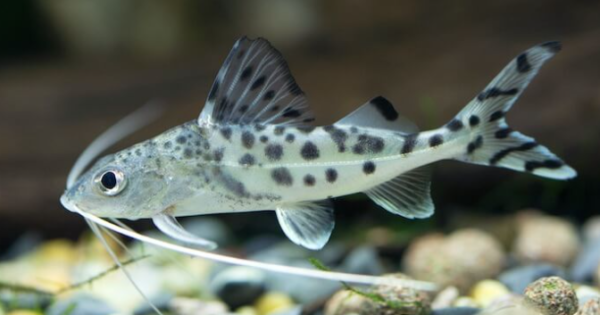
The Pictus Catfish is a nocturnal fish native to South America that you can find in freshwater and saltwater. Depending on the species, picture catfish live for 8 to 10 years on average, and it’s relatively uncommon for them to reach the same length as their body. The most critical component of the Pictus catfish habitat is a quiet, daytime resting spot.
- Size- 5 to 6 inches
- Difficulty- Beginner
- Minimum Tank Size- 50 gallons
34. Blue Gourami

It is a natural color variant of brown or lavender gourami. The blue gourami, usually whitish-blue in hue, is one of the most popular gourami species. They may be found in several Southeast Asia, and they are most often found in lowland marshes and swamps densely vegetated.
Blue gouramis are territorial and may come into conflict with other species. The average blue gourami lifetime is around five years if kept in optimal living circumstances.
- Size- 5 inches
- Difficulty- Easy
- Minimum Tank Size- 20 gallons
35. Diamond Tetra

The diamond tetra is a South American tetra species that evolved in Venezuela’s Lake Valencia. It belonged to the Characidae family and was given the name “diamond tetra” because its scales refract light in the same manner as a sparkling diamond does. Adult diamond tetras range in length from 2 to 2.4 inches, depending on size and gender. Its fins are generally semi-transparent, with a violet tint on the underside.
- Size- 2.5 inches
- Difficulty- Beginner
- Minimum Tank Size- 15 gallons
36. Rubber Lip Pleco

Rubber Lip Plecos have a tapering body with a large sucker mouth and eyes at the top of their heads. The Magdalena River in Columbia and the Apure River in Venezuela are its native habitats, where they may be found in considerable numbers.
Rubber Lip Plecos are quite easy to care for since they are adaptable fish. A rubber lip pleco may live for roughly 10-12 years if properly maintained.
- Size- 5-7 inches
- Difficulty- Easy
- Minimum Tank Size- 25 gallons
37. Zebra Danio

The distinctive horizontal stripes of the zebra danio set it apart from other danios. Zebra danios were discovered in schools in India, Bhutan, and Bangladesh, where they are native to tropical and subtropical waters.
Because of its small size, it is an ideal option for a community aquarium. The zebra danio’s biological environment changes according to the season. When thoroughly developed, zebra danios may reach a length of up to 2.5 inches.
- Size- 2.5 inches
- Difficulty- Easy
- Minimum Tank Size- 10 gallon
38. Harlequin Rasbora

The harlequin rasbora is a bird only found in Malaysia, Singapore, Sumatra, and Thailand’s southern area. Because of their brilliant color and unusual patterns, you can put on a magnificent show in aquariums of any size. The body, in this case, is reddish-copper, with a tremendous black wedge running the length of the rear half of the instrument. The Harlequin Rasbora lives between 5 and 8 years, depending on the breed.
- Size- 1.75 inches
- Difficulty- Intermediate
- Minimum Tank Size- 10 gallon
Conclusion
There is plenty of other unexamined, unnoticed community fish out there that merits one’s attention. Fortunately, a lot of aquarists are starting to notice these fish and giving them a chance to add life and beauty to any community tank. Next time you go to a pet shop, take a closer look at the fish you’ve glanced over. Observe their subdued colors, the hidden majesty of their fins, or the dimmed glow behind their eyes; perhaps the drabbest fish in the pet store ends up being the most fab fish in your home tank. After all, more spectacular and stranger things have happened to the most ordinary-looking fish when given a chance to shine.
